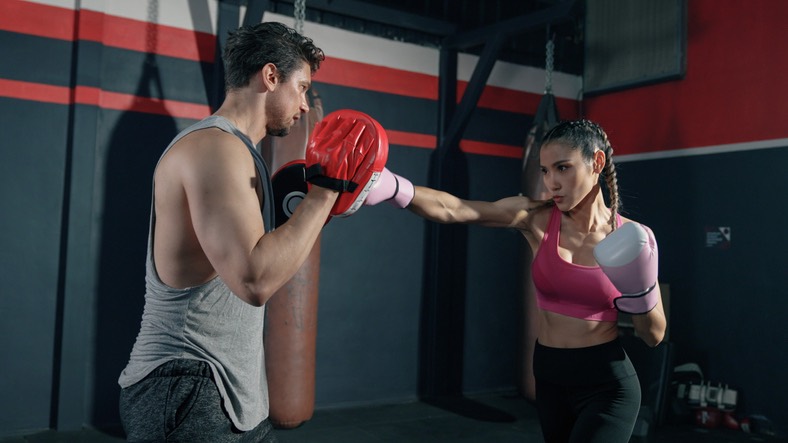Starting a Martial Arts Class as an Adult

Popular shows like Cobra Kai and Kickin’ It make it look like martial arts is kid stuff. It doesn’t help that if you pop your head into a lot of dojos, you’ll find that most classes are aimed at children and teens.
But plenty of adults practice martial arts, and some like me even start in their thirties, forties, and later.
And you can, too.
Why Study the Martial Arts?

Most of the people I’ve met in adult classes joined with their kids. And it’s true. Martial arts can be a fun way for families to spend time together and get some exercise.
But there are many other benefits of martial arts training.
Some people train because they want to learn self-defense. You can learn self-defense skills from some types of martial arts training, but different schools emphasize different skills, so it’s important to do your research before signing on the dotted line.
I started training because I wanted to get fit. Martial arts can be great for physical fitness, but again, do your research. Some styles are more vigorous than others, and some may emphasize muscle work over cardio or vice versa.
Think about the health benefits you want to explore. Do you want to increase your strength? Speed? Cardiovascular health? What about stress relief? Different forms of martial arts can help you to achieve these benefits and more.
Martial arts training is often recommended to help kids develop self-confidence, discipline and perseverance, but guess what? Adults can benefit from these things, too.
Progressing from white belt to black belt means setting large goals and small ones, and working toward them consistently. It’s a powerful feeling to accomplish something significant and life altering, while watching your skills grow along the way.
It can help in other areas of your life as well. In fact, I credit my Taekwondo practice with giving me the confidence, discipline and perseverance to write (and sell) my first novel. You might be surprised at what you can accomplish when you set your mind to it.
Can I Start Learning Martial Arts at 40?

You bet!
I did, and if I could do it at age 40 and in, (let’s be honest), pretty pathetic physical condition, you can, too.
In fact, there are plenty of martial artists a lot older than me who are still training, sparring, competing, and loving it.
There’s no such thing as being too old, provided you pick the right style and the right instructor and prioritize your health.
I’ll tell you how to do that in a bit.
What's the Best Martial Art to Start Out With?
The best martial art is the one that you enjoy doing. Because, like anything, if you hate it, you’re going to avoid doing it.
Remember that instructors and schools may run their classes differently, regardless of their martial arts style, so it’s important to visit multiple schools and see where you feel most comfortable.
Here are a few of the more common styles.
Aikido
Aikido is a Japanese self-defense art. The name means “the way of the harmonious spirit.” The goal of Aikido is to disarm an attacker without hurting them. Practitioners learn joint locks, throws, rolls, and other techniques to accomplish this.
Brazilian Jiu-Jitsu (BJJ)
Brazilian Jiu Jitsu is a modern self defense and combat sport. Its main techniques are grappling, ground fighting, and submission holds. The interesting thing is that someone armed with the right techniques can handily subdue a larger, stronger untrained attacker.
Judo
Judo is a Japanese martial art that focuses on grappling, throwing, and striking. Much of the in-class work is done with a partner. Judo is a recognized Olympic sport, and many people practice it competitively.
Karate
Karate is another Japanese martial art. There are many different kinds of Karate, but all teach blocks, kicks, strikes, and stances. Classes often involve practicing techniques, kata (combinations of techniques), and kumite (sparring). If your school has a sensei, chances are, you’re studying Karate.
Kickboxing (Muay Thai)
Muay Thai is a combat sport that uses cliches and strikes. It can be very physically demanding. Muay Thai is best known for its strikes involving the shins, elbows, fists, and knees.
Krav Maga
Krav Maga is an aggressive martial art that was developed by the Israeli Defense Forces. It combines techniques from Aikido, Judo, Boxing, Karate and Wrestling. The focus of Krav Maga is learning practical self defense that can be applied to real life situations.
Kung Fu
“Kung Fu” refers to a wide variety of Chinese martial arts.
“External” Kung Fu styles involve blocking, kicking, striking, and cardiovascular development.
“Internal” Kung Fu styles, like Tai Chi, focus on energy, slow movements, and breath. Internal Kung Fu styles can be excellent for stress relief.
MMA (Mixed Martial Arts)
Mixed Martial Arts combine elements of traditional martial arts styles and other fighting styles such as boxing. The curriculum and focus can vary widely from school to school, so it’s important to visit in person and maybe even try out a class to see if a given program is for you.
Tae Kwon Do
Taekwondo is a Korean martial art, which, like Karate, involves blocks, kicks, and strikes. There are two main types: Olympic Taekwondo (governed by the World Taekwondo Federation) and self-defense oriented Taekwondo (governed by the International Taekwondo Federation).
Both may take their students to tournaments.
What is the Best Martial Arts Class for Older Adults?

Again, the best martial arts class for anyone is the class that ticks all your personal boxes, and which you enjoy. But adult martial arts students have some additional things to consider.
1. Stretching
As we get older, it’s easy to lose the flexibility that comes so naturally to kids. This means that adults have a greater risk of injury, and injuries can sideline us for longer than they used to.
You can get your flexibility back, for sure, but your dojo will have to support that. Look for classes that start and finish with a good stretch. At my dojo (or dojang, since I study Taekwondo), we stretch for ten to fifteen minutes at the beginning and end of every class.
If an instructor skips the stretching, it’s best to give that school a miss.
2. Cardio Concerns
If you, like a lot of working parents, spend a lot of time at a desk, you may not have the cardiovascular fitness you had as a younger, more active person. Consider scheduling a chat with your doctor before embarking on your martial arts career, just to be safe.
Even if you are fit, picking up a new activity will challenge your heart and lungs in ways that you’re not used to. Try out a few different types of martial arts to see which gives you the challenge you want without leaving you gasping for breath.
For gentle exercise, try Tai Chi. Taekwondo, Aikido, and Karate provide moderate exercise. And if you’re up for a serious cardiovascular challenge, check out Muay Thai or Brazilian Jiu-Jitsu.
3. Muscle Work
If you’re starting from a sedentary place, even a gentle martial arts workout will challenge your muscles. You will almost certainly be sore afterward. This doesn’t mean you should give up. The stronger and fitter you become, the less it will hurt. But it’s important to be prepared.
That said, never ignore an injury. Learn to recognize different types of sports injuries, and see your doctor when necessary.
Styles of martial arts that are heavy on muscle work include Judo, Brazilian Jiu-Jitsu, and some types of MMA. Taekwondo, Karate, and many Kung Fu families provide a moderate muscle challenge.
How Do I Find a Good Martial Arts Class?

Martial arts classes come in many shapes and forms, so chances are, you’ll find one that suits your needs.
Here’s how to start your search.
First, think about which style or styles you’d like to try. Don’t be too rigid with your choice. If you try a few different styles, you might be surprised which one you actually end up liking best.
Next, make a list of martial arts schools in your area that may fit the bill. Most schools will have a class schedule on their website, so look for adult classes that you can easily fit into your life.
Schedule an observation or test class. If a school demands that you sign a contract before even observing a class, this is a huge red flag. Strike that school off your list.
This last step is the most important. After your observation or test class, ask yourself these questions:
- How did you feel about the intensity level of the class?
- Were there adequate warmups and cool-downs?
- Did you feel respected and comfortable?
- Were students and instructors friendly?
- Was safety a priority?
- Was it fun?
There are a few other things to consider when choosing a specific school.
Large martial arts school chains have the advantage of a standardized curriculum and multiple locations. The downside is that they often lock students into expensive, long-term contracts.
Individually owned schools may be less expensive and more willing to work with your budget. But you will still probably have to sign an annual contract.
You might also be able to find classes taught through your local parks and recreation department, junior college, or community center. These classes are often less expensive and shorter term than classes taught through martial arts schools, and generally don’t require a contract.
Training with Your Kids: Yes or No?

As I said before, lots of adults make martial arts part of their family fitness plan and train with their kids. But should you? Ask yourself a few questions.
Are you looking for “me time” or “we time”? Martial arts can be either, and if you want to train by yourself, that’s ok!
Are you working with a limited budget? If so, then invest in your own training and take your kids to run off their energy at the park.
Whose idea is martial arts training? If it’s your kids’ idea, then by all means, let them give it a try. If they’re so-so on the idea, though, they might prefer more informal types of exercise.
Are You Ready to Get Kickboxing?
Kids’ martial arts is big business. But a lot of adults get great satisfaction from their martial arts practice, and you can, too!

